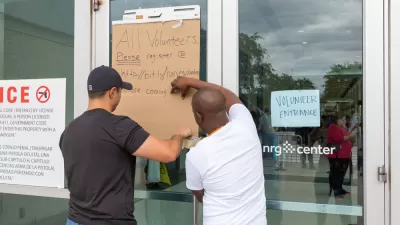“In recent days, the Netherlands’ peerless expertise and centuries of experience in battling water have been widely hailed in the United States as offering lessons" for New York and for other cities alike, writes Andrew Higgins.
So, what is it that makes the Dutch way of preventing floods so compelling as a model? The operative word here is preventive, but it is also based on years of experience.
"[A]n elaborate and highly effective Dutch defensive system... includes flood-control techniques first developed in the Middle Ages and futuristic steel structures that, operated by computers, move to block storm surges when water levels rise too high," describes Higgins. Dutch expertise is based on a history of dealing with mighty storms and devastation, as well as consequent policy decisions and capital investment aimed at preventing this in the future. With that said, the Dutch government has spent billions in large construction projects such as the Delta Works, including steep annual maintenance costs for these systems.
Challenges the U.S. would face in implementing flood prevention strategies would include changing its approach to disaster mitigation from a focus on management to one centered on avoidance. "The U.S. is excellent at disaster management," but "working to avoid disaster is completely different from working after a disaster," says Wim Kuijken, the Dutch government's senior official for overall water control policy. Furthermore, the U.S. would need to leverage funding for comparable megaprojects, and finding ways to tailor flood prevention strategies to the local geography and situation.
For New York, this might not necessarily translate into building huge barriers the Dutch way, but finding more appropriate and less expensive solutions like building flood-proof entrances for subway stations and parking structures, warns Bas Jonkman, professor of hydraulic engineering at Delft University of Technology. In fact, in recent years, Dutch prevention measures have also shifted towards prioritizing "enlarg[ing] defenses in a natural way," says Kuijken, including dumping "706 million cubic feet of sand off the coast north of Rotterdam to promote the formation of protective sandbars."
FULL STORY: Lessons for U.S. From a Flood-Prone Land

Planetizen Federal Action Tracker
A weekly monitor of how Trump’s orders and actions are impacting planners and planning in America.

Restaurant Patios Were a Pandemic Win — Why Were They so Hard to Keep?
Social distancing requirements and changes in travel patterns prompted cities to pilot new uses for street and sidewalk space. Then it got complicated.

Map: Where Senate Republicans Want to Sell Your Public Lands
For public land advocates, the Senate Republicans’ proposal to sell millions of acres of public land in the West is “the biggest fight of their careers.”

Maui's Vacation Rental Debate Turns Ugly
Verbal attacks, misinformation campaigns and fistfights plague a high-stakes debate to convert thousands of vacation rentals into long-term housing.

San Francisco Suspends Traffic Calming Amidst Record Deaths
Citing “a challenging fiscal landscape,” the city will cease the program on the heels of 42 traffic deaths, including 24 pedestrians.

California Homeless Arrests, Citations Spike After Ruling
An investigation reveals that anti-homeless actions increased up to 500% after Grants Pass v. Johnson — even in cities claiming no policy change.
Urban Design for Planners 1: Software Tools
This six-course series explores essential urban design concepts using open source software and equips planners with the tools they need to participate fully in the urban design process.
Planning for Universal Design
Learn the tools for implementing Universal Design in planning regulations.
Heyer Gruel & Associates PA
JM Goldson LLC
Custer County Colorado
City of Camden Redevelopment Agency
City of Astoria
Transportation Research & Education Center (TREC) at Portland State University
Camden Redevelopment Agency
City of Claremont
Municipality of Princeton (NJ)





























